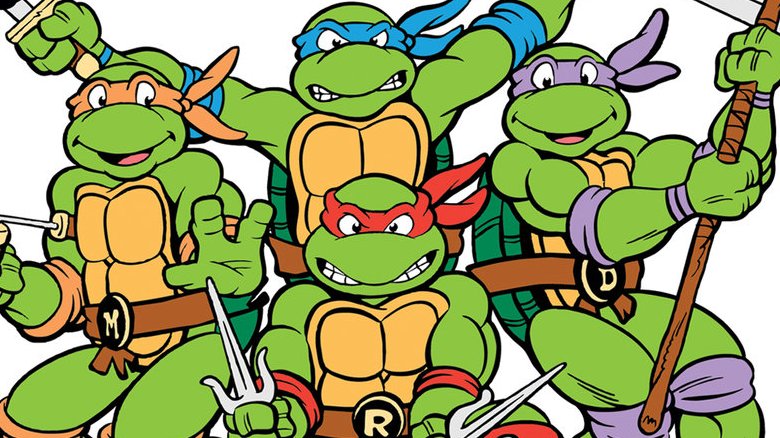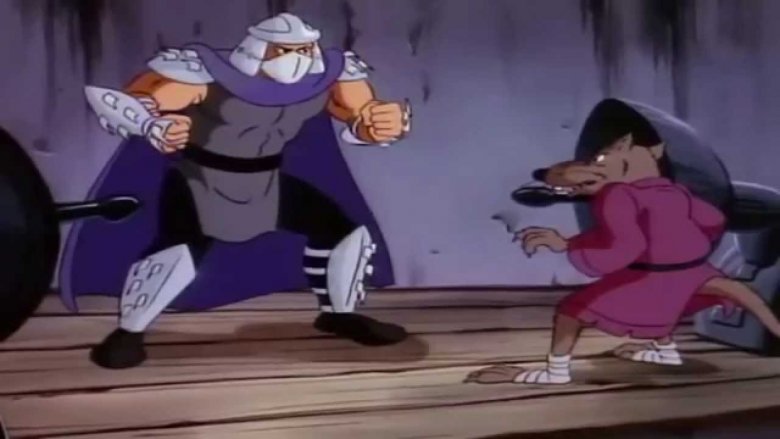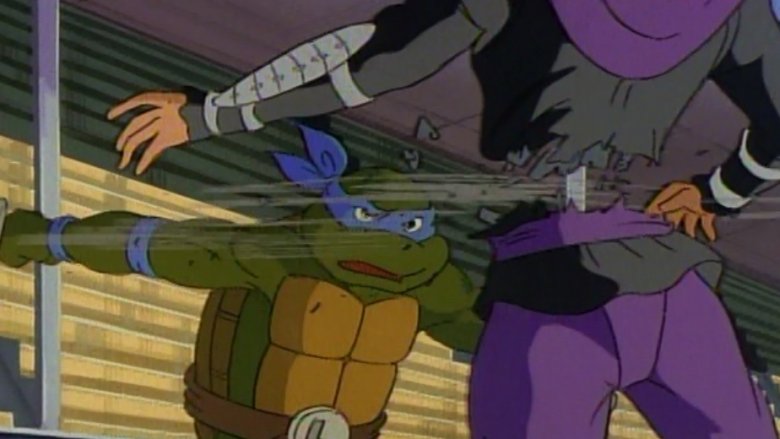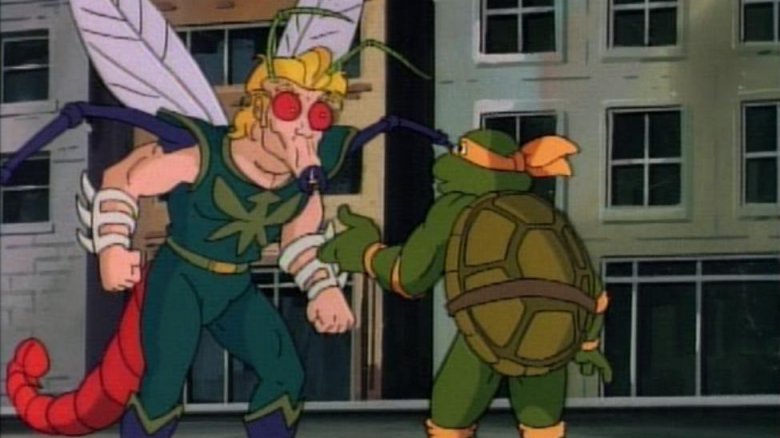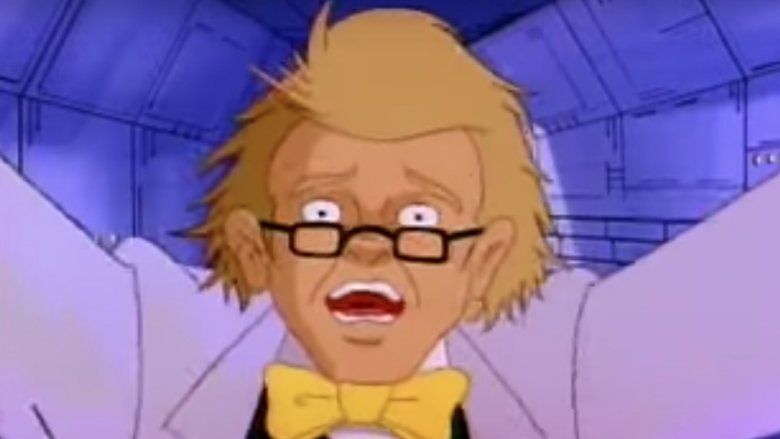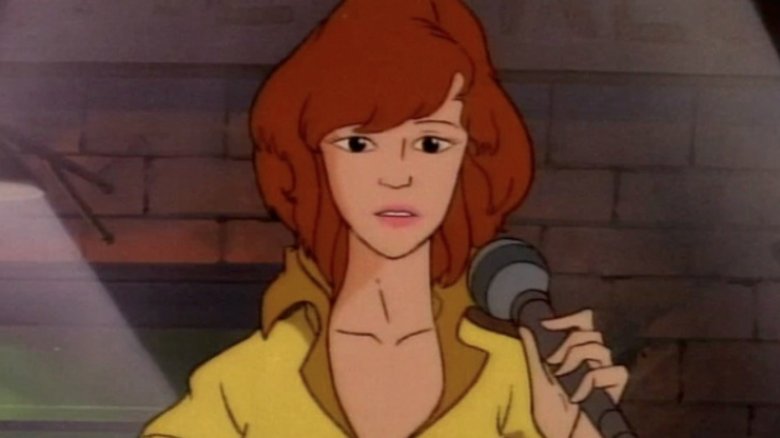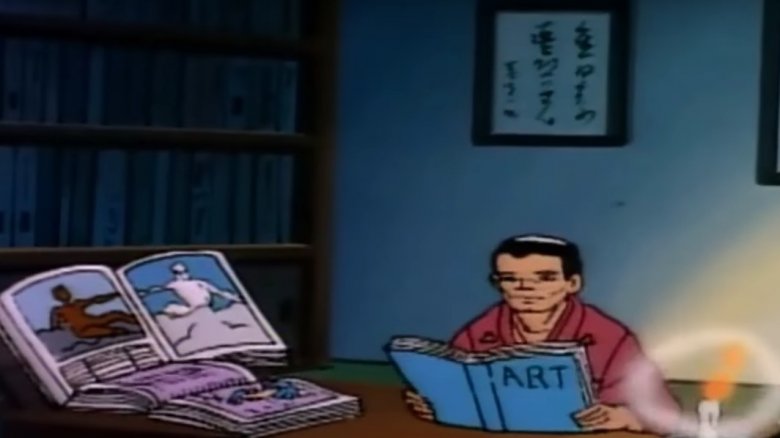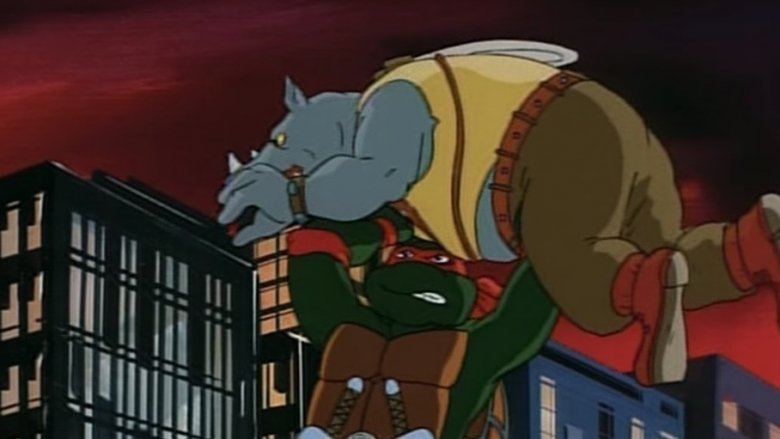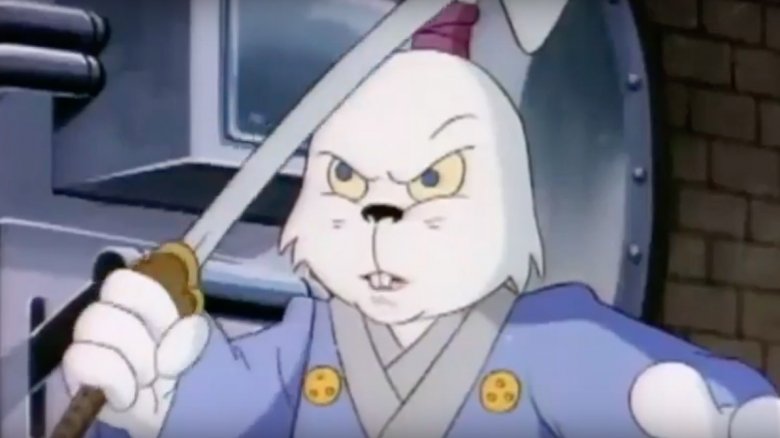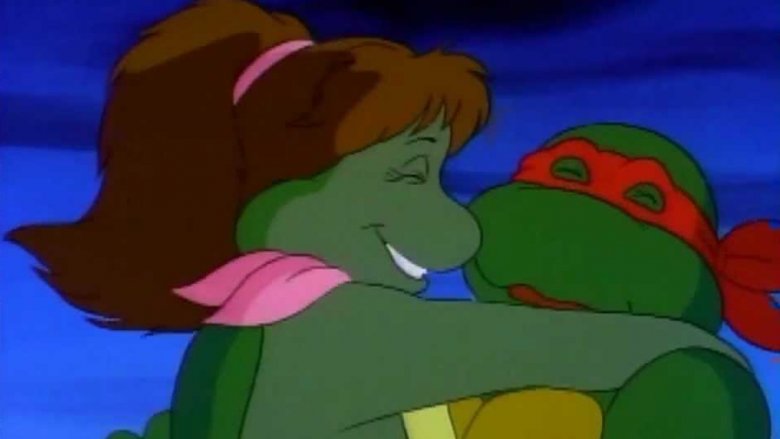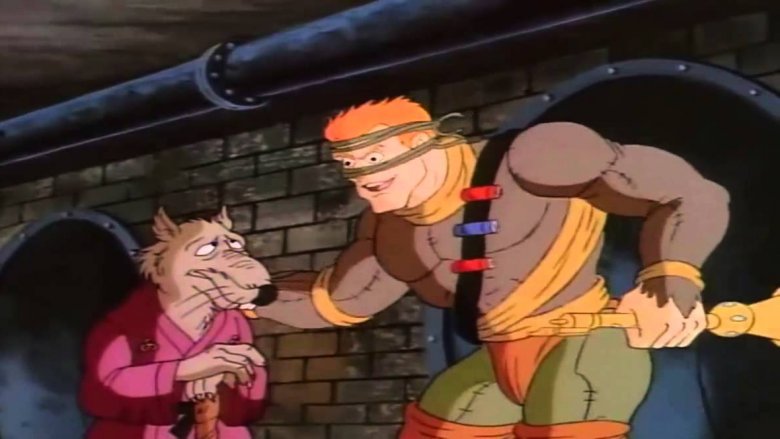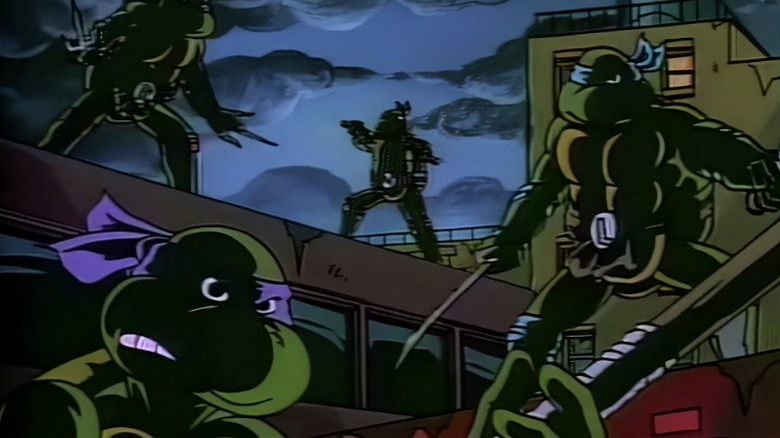Things Only Adults Notice In The Teenage Mutant Ninja Turtles Cartoon
Teenage Mutant Ninja Turtles became a multimedia phenomenon by combining four things kids love: mutants, ninjas, teenagers, and turtles. Well, maybe "turtles" is a stretch, but you can't argue against the success of the high concept: Leonardo, Michelangelo, Raphael, and Donatello have become household names — and not just because of their Renaissance artist counterparts. Originally created by Kevin Eastman and Peter Laird as a black-and-white parody comic of popular superhero tropes, the Teenage Mutant Ninja Turtles have been adapted into everything from video games and LEGO sets to movies and cartoons.
While the lion's share of the credit for the surprisingly bankable characters must obviously go to Eastman and Laird, their first TV series — airing in syndication from 1987-1996 — also paved the way for generations of children to scream "Cowabunga!" and argue over who got to be Raphael and who was stuck being Leonardo. Still, when you go back to watch the original animated series, there are a lot of bizarre details that flew right over our heads as children. Here are the things that only adults will notice in the Teenage Mutant Ninja Turtles cartoon.
Shredder, master of shredding?
Every great hero needs a great villain, and the Turtles have to contend with the indomitable Shredder. Part Doctor Doom, part Kingpin, The Shredder is a villainous mastermind as adept at fighting as he is at scheming.
Even his reputation, however, doesn't come close to excusing his ridiculous name. Even in a world where turtles can be both ninjas and named after famous Renaissance artists, naming a villain after the least threatening kitchen implement is a strange choice. Every cartoon villain is forever doomed to helplessly watch as all his schemes are perpetually foiled by the good guys — that's what makes 'em cartoon villains, after all — but with such a silly sobriquet, this is one bad guy who really set himself up for a lifetime of particularly humiliating failure. Perhaps the most bizarre thing about the Shredder is that he has a perfectly fine real name (Oroku Saki) that he could use instead of his ridiculous alter ego.
Broadcast Standards & Practices Approved
Action cartoons have to ride a fine line between showing the cool fight scenes that fans want while keeping everything more or less child-friendly in the eyes of Broadcast Standards & Practices. BS&P, as it's more commonly known, is a department at each television network that's tasked with making sure that content abides by their larger standards. In the case of Teenage Mutant Ninja Turtles, that created a bit of a pickle for the creators: both Raphael and Leonardo use stabbing weapons, which meant that fight scenes featuring those two characters would have to stay away from using their signature weapons on their opponents.
An elegant solution was to keep the Foot Soldier character designs that Laird and Eastman had created, but replace the ninjas themselves with ninja robots. By re-establishing that the Turtles were smashing robots and not slicing people in half, the cartoon was able to stay surprisingly accurate to the ninja action featured in the comics.
Body horror abounds
As much as Broadcast Standards & Practices were watching for violence in the show, they sure seemed to miss just how horrifying the various characters' journeys could become.
The cartoon seemed to delight in constant mutations for Teenage Mutant Ninja Turtles' human characters, with Baxter Stockman's gruesome transformation into a Fly-Man easily ranking among the worst. Even besides the Goldblum-esque transformation of Stockman, there were dozens of mutants and transformations and they were almost always accompanied by the person's dumbfounded horror at what their formerly human bodies had turned into. Even main character April O'Neil had to suffer through three distinct mutations over the course of the series (thankfully all reversed eventually).
Deeply rooted body horror is a bit of a heady subject for a Saturday morning cartoon, and that's without considering the Turtles' own body dysmorphia — after all, we're talking about humanoid turtles that are also teenagers. Talk about a rough hormone period.
Whitewashed characters
Despite the show's heavy emphasis on mutants, aliens, and robots, Teenage Mutant Ninja Turtles had a deep roster of human characters. Unfortunately, they were almost entirely white — an exclusionary practice that looks even worse when you realize that both Baxter Stockman and April O'Neil were whitewashed for the cartoon adaptation. In the case of Stockman, the prevailing theory is that the character's inferior relationship to Shredder would have seemed racist were the character to remain black. As it is, having almost no black characters across almost a dozen seasons seems slightly more racist.
In the case of April, it's a bit more complex. Eastman and Laird have disagreed about April's original ethnicity; Eastman drew her as a mixed-race woman (visually based on his then-girlfriend, April Fisher), while Laird has said that she was always meant to be a caucasian redhead. While the record isn't quite clear about whether the character was technically whitewashed for the cartoon, April being a white woman does mean that there were almost no characters of color in the entire show (Yes, technically Bebop was black, but he spent nearly the entire show's run as a mutant, so it doesn't really count).
Lois Lane in a yellow jumpsuit
Speaking of April O'Neil, it can be striking when you rewatch Teenage Mutant Ninja Turtles as an adult just how blatantly her character boils down to little more than Lois Lane with a more utilitarian wardrobe and different hair color. They're both in the same career field and they both have the same basic personality type: journalists whose deep desire to uncover a story often gets them in trouble, necessitating superheroic rescues. Ultimately, the biggest difference between them seems to be that Lois gets to dress up while April is forever stuck in a yellow jumpsuit. Well, that and their choice of superhero boyfriends — Lois Lane definitely got the better end of that deal, soaring across the sky with a super-hunky Kansas reporter who turned out to be a literal superman, while April had to repeatedly fend off the affections of mutants — and co-workers with even worse behaviors than mutants.
Turtle Renaissance
The Turtles' names have become as iconic as the signature weapons they wield, but the deeper meaning behind them is actually pretty shallow. The Turtles are named after Splinter's favorite Renaissance artists (and meta-textually, after Eastman and Laird's favorite Renaissance artists), but the names themselves don't actually reflect any of the Turtles' personalities. Michelangelo the Renaissance painter was known for the Sistine Chapel and being arguably one of the greatest artists of all time. Michelangelo the Ninja Turtle is known for being a party dude.
Unless we missed an episode of TMZ focusing on Renaissance painters, there's really no connection between Turtle and artist, so why are they named so specifically? Even beyond that, if you were to name the four greatest painters of the Renaissance, Botticelli would arguably edge out Donatello. Botticelli, after all, was known for "The Birth of Venus," which defines the popular conception of Renaissance art to this day. Donatello was much better known for being a sculptor, rather than a painter like his Turtle-named contemporaries.
The last few seasons get REALLY dark
While the original Teenage Mutant Ninja Turtles animated series is known for being fairly child-friendly, the last few seasons were so dark that they almost seemed like an entirely different show. Besides the new villain Lord Dregg, the Turtles found themselves mutated into new forms, the Channel 6 building is blown up, and the sky literally turns red — a detail that led fans to refer to the final three seasons of the show as the "Red Sky" seasons.
The show's pivot to darker episodes and a more classically alien-looking villain seemed to be a gambit to compete with Power Rangers, which had started to siphon off the young fanbase for TMNT — or at least that was the fan explanation for the changes. Regardless, it wasn't able to overcome its declining ratings, and the show ended at season 10 with a tone miles removed from the relatively light antics of season one, episode one.
Usagi Yojimbo
The Turtles had plenty of allies — human, mutant, and robot alike. One of the most memorable, however, was the samurai rabbit Miyamoto Usagi — or as the cartoon referred to him, Usagi Yojimbo. As comics aficionados are no doubt already aware, Usagi is actually the lead of another beloved, long-running black-and-white comic about anthropomorphic animals, titled — you guessed it — Usagi Yojimbo.
The massive thematic overlap — or creative debt, whatever you want to call it — between Usagi Yojimbo and Teenage Mutant Ninja Turtles is obvious at first glance. To their credit, the Turtles haven't been shy about embracing the similarities between the two universes; in fact, the characters have had crossovers in nearly every TMNT iteration since the beginning. In the cartoon, Usagi makes an appearance in two episodes — "Usagi Yojimbo" and "Usagi Comes Home" — which features him visiting the Turtles' dimension and getting embroiled in samurai hijinx with Shredder.
What is love?
A person could definitely be forgiven for assuming that an animated, nominally kid-friendly show that featured so many aliens and mutants might understandably veer away from romantic pairings. For whatever reason, however, Teenage Mutant Ninja Turtles went in the opposite direction, offering viewers stories that were packed to the brim with a whole messy menagerie of interspecies crushes.
Michelangelo had a flirtation with Kala, a Neutrino girl from Dimension X. Leonardo and Lotus had an on-again, off-again romantically charged rivalry. Irma's libido, meanwhile, was so aimless it was usually played as a running gag. Is it all a little too weird to think about while watching Teenage Mutant Ninja Turtles as an adult? Definitely. But on the other hand, there's also something almost wholesome about how romantically open all the characters on the show could be towards mutants and aliens. Still, best to not think about the specific details for too long.
Only '90s kids will remember sewer kings
There must have been something in the water (or the sewers) in the '90s, because animators seemed to latch on to an oddly specific character archetype: a mentally ill man who flees to the sewers in order to declare himself king of the rats and the filth. Variations on this character appear in both Teenage Mutant Ninja Turtles as the Rat King and in Hey Arnold as the Sewer King, and the personality differences between them are basically nil. Both aren't necessarily evil, just misguided souls who have decided to make a home within a teeming city's waste system until they're confronted by the shows' respective heroes.
While it would be easy to assume that the writers of Hey Arnold were inspired by the Rat King in TMNT, maybe the '90s were just full of sewer-dwelling regents. Hey, it makes more sense than alligators living in the New York Sewer system, and plenty of people think that actually happened!
Chuck Lorre wrote the theme song
If there's one thing that every fan of the Teenage Mutant Ninja Turtles knows and loves, it's the theme song. It's a relentlessly catchy tune, played over colorful opening credits that showcase some great animation while lyrically highlighting the Turtles' respective personalities in a goofy-but-fun rhyme scheme: "Splinter taught them to be ninja teens / Leonardo leads, Donatello does machines / Raphael is cool but rude / Michelangelo is a party dude!" To put it simply, the song is a hit.
The awesomeness of the Teenage Mutant Ninja Turtles cartoon's theme song really shouldn't surprise anyone, considering who co-wrote it (along with Dennis Brown): proven hitmaker Chuck Lorre, the creator of Two and a Half Men and The Big Bang Theory. And even though he's since gone on to massive success as a sitcom king, Lorre is still proud of his old song's longevity. "We wrote it in an afternoon and we recorded it in an evening," he later marveled. "And it's still alive! How cool is that?"
